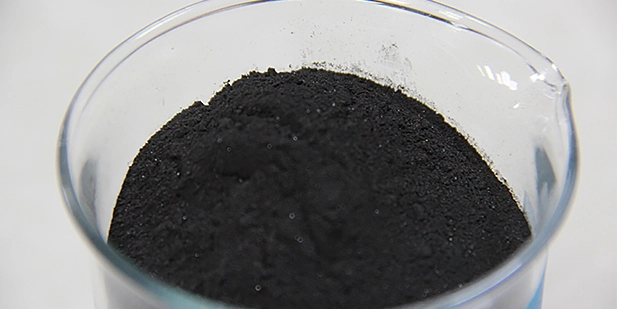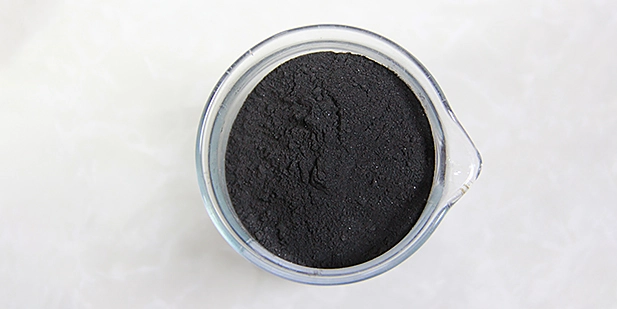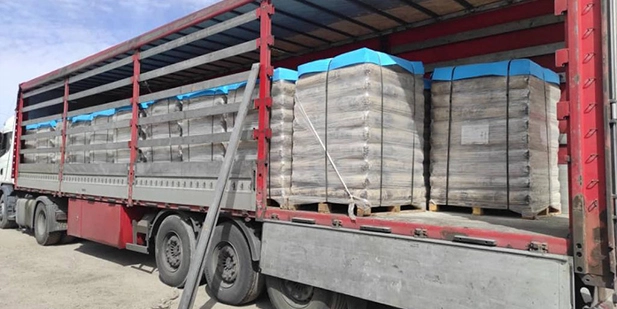What is Gilsonite and Why it Matters?
Gilsonite is a black, shiny bitumen (or simply asphalt) that’s formed
naturally over millions of years as a result of the solidification of crude oil under extreme pressure. This obsidian-looking material is very brittle, and thus is often used in powder (Gilsonite Powder) and liquid form (Liquid Gilsonite).
Gilsonite primarily consists of carbon, however, it also has traces of hydrogen, nitrogen, Oxygen and sulfur. It has unique properties and thus is extremely valuable for a variety of industrial and non-industrial applications including drilling, road construction, and production of pharmaceuticals and cosmetics.
Gilsonite is often found in specific geological formations including in western Iran and is
typically mined from below the earth’s surface in veins or seams within sedimentary rocks that often include oil shale and bituminous sandstone formations.
Gilsonite is commonly referred to as natural asphalt but it is also known as Asphaltite, Asphaltum, Uintahite, Uintaite or Oil Sands depending mainly on the geographical location of its deposit. If you are still interested to know more about Gilsonite’s other names, make sure to check out its wikipedia page!
What is Gilsonite Used for?
Gilsonite is a naturally occurring (that’s why it is called Natural Asphalt, duh!) highly adhesive and yet very elastic material. It is thoroughly water resistant and has a relatively high melting point. Additionally, it is resistant to chemicals, and weathering.
Here are some of the more interesting properties of Gilsonite:
High solubility: Unlike most asphalts, it readily dissolves in specific solvents like toluene and carbon disulfide.
Lightweight: Despite its black, rock-like appearance, it's surprisingly light, contributing to its versatility.
Thermal resilience: Its high melting point makes it ideal for applications requiring heat resistance.
Superb adhesion: Gilsonite exhibits excellent adhesion to various materials, from metals and wood to paper and asphalt.
Elasticity and flexibility: Unlike brittle asphalts, Gilsonite offers some degree of stretch and bend, enhancing its performance in demanding applications.
These properties have made Gilsonite, aka asphaltite, a highly versatile material and a household name across different industries and for various applications.
Some of the more common uses of Gilsonite include:
Asphalt Modification: One of the significant uses of Gilsonite is in modifying asphalt. It is often added to asphalt mixes to improve the performance of road surfaces. Gilsonite-modified asphalt shows enhanced durability, increased resistance to deformation, temperature fluctuations, aging and weathering. The modified asphalt also demonstrates reduced susceptibility to rutting, cracking, and fatigue, making it ideal for high-stress applications and environments.
Drilling Fluids: In the oil and gas industry, Gilsonite is a key ingredient of drilling fluids. It helps lubricate the drill bit, increase the viscosity of drilling mud, and provide stability to the wellbore, especially in challenging geological formations. Gilsonite also helps with minimizing fluid loss during drilling operations.
Inks and Paints: Gilsonite is also used in the production of inks and paints due to its unique chemical composition and physical properties. It improves the adhesion and durability of these products and It imparts a lustrous finish to them. When used in the production of inks, Gilsonite prevents the finished product from smudging. All things considered, Gilsonite improves the overall quality of the coatings.
Foundry Sands: In foundry applications, Gilsonite can be added to molding sands to help reduce gas evolution during metal casting which in turn results in improved casting quality. This versatile bitumen acts as a binding agent, contributing to the creation of strong and stable molds.
Sealants and Adhesives: The viscose material is widely used in the formulation of sealers and adhesives to improve their flexibility and adhesion while also increasing their resistance to destructive environmental factors including stress and temperature variations. Gilsonite-modified sealants are known for their ability to withstand harsh and extreme conditions.
Carbon and Graphite Production: Gilsonite is predominantly made up of intricate hydrocarbons. This high carbon content makes it suitable for applications where carbonization is required like in the production of electrodes and the metallurgical industry.
Waterproofing and Insulation: Gilsonite is naturally hydrophobic, repelling water and forming a protective barrier against moisture. Thus another application of Gilsonite is waterproofing and insulation of materials. Gilsonite readily sticks to various surfaces like concrete, metal, and asphalt, making it an effective adhesive for waterproofing membranes and sealants. At the same time its elastic nature allows for expansion and contraction due to temperature changes, preventing cracks and leaks.
Agricultural Products: While not as prominently used as in other industries, Gilsonite does find some niche applications in the world of agriculture. Its unique properties offer specific benefits in certain areas, though it's important to recognize that its use in agriculture is limited and still under development. It is
mostly used in the production of fertilizers, pesticide and fungicide carriers and soil stabilizers.
Gilsonite's diverse applications far exceeds the aforementioned areas. It is also used in electrical insulation, metal alloy processing, steel desulfurization, friction and wood products.
When mined, Gilsonite comes in chunks that vary in size but can be quite large and heavy. Gilsonite is first crushed into powder which is also known as asphalt powder or natural bitumen powder.
The powder then can be dissolved or suspended in a liquid carrier to make liquid Gilsonite or Gilsonite concentrate, for easier handling and application in various industries.
What is Liquid Gilsonite?
Gilsonite itself is a solid material, so when it is processed into a liquid form, it becomes more versatile for various industrial applications, especially within fluid systems. Unlike its natural solid, rock-like form, when liquefied, Gilsonite readily disperses and blends within liquids. It spreads faster and more evenly, ensuring consistent performance and avoiding clumping. This method also allows for higher concentrations in the final mixture compared to solid forms.
Liquid Gilsonite is just one facet of this versatile resource. Its unique properties continue to be explored and adapted for new applications across various industries. Overall, Gilsonite goes beyond just another industrial material. Its wide application in the production of various products has made it an extremely appealing material. As the demand for these products continues to grow, the demand for Gilsonite is likely to increase as well.
Where does Gilsonite Come from?
The formation of Gilsonite or natural asphalt is a story eons in the making, involving ancient oceans, geological pressures, and fascinating chemical transformations. Gilsonite is thought to have formed millions of years ago from the fossilized remains of algae and other aquatic organisms. Over time, these organic materials were buried under layers of sediment and subjected to heat and pressure, which transformed them into the black, brittle substance we know today.
Gilsonite or asphaltite often forms in veins or seams within sedimentary rocks, such as shale and sandstone. The newly formed Gilsonite may migrate through the porous spaces in rocks until it encounters a suitable reservoir or trap where it can accumulate and form concentrated deposits.
The exact formation process of Gilsonite is, however, still debated, with some scientists proposing alternative theories involving seeps of oil or hydrothermal vents.
But where is Gilsonite found?
Gilsonite deposits are found in certain regions, including the United States, Iran, Turkey, and some parts of South America. The quality and properties of Gilsonite can vary depending on its source.
When it comes to major Gilsonite deposits, the clear winner is the Uinta Basin in Vernal county in northeastern Utah, USA. This region holds the title of having the world's largest and most commercially viable deposits of this valuable resource.
Aside from boasting vast and thick veins of Gilsonite stretching kilometers in length and width, the naturally formed bitumen found in the Uinta Basin generally exhibits superior quality with minimal impurities and consistent properties compared to those extracted from other locations. Additionally, the geographical location and geological formation allow for easier access to the veins, making it an easily accessible and abundant resource.
Colorado and Wyoming are other US states that have Gilsonite reserves though limited in quantity and depth. Trace amounts of Gilsonite exist in other locations across the world like Iran. These deposits are much smaller, harder to reach, and often of lower quality.
In Iran, Kermanshah province has the largest deposits while there are mines in Lorestan, Ilam and Khuzestan provinces as well. Colombia and Venezuela in South America, and Turkey in Eurasia are other locations known to have Gilsonite deposits. These deposits, however, are smaller, deeper, and often in remote areas, increasing extraction costs and logistical challenges.
The geographic distribution of Gilsonite deposits is crucial in understanding where this unique hydrocarbon resin is formed and sourced, and it plays a role in the availability and characteristics of the material in different markets.
It's equally important to note that the formation of Gilsonite is part of the broader geological processes that lead to the development of hydrocarbons. The specific conditions and geological history of a region determine the quality, quantity, and characteristics of the Gilsonite deposits found there.
Mining Gilsonite:
The extraction of Gilsonite involves mining the deposits and processing the raw material to remove impurities and prepare it for various uses. This typically involves crushing, grinding, and purifying the raw material into different forms and grades, depending on the final product demand.
There are at least two methods currently in use for mining Gilsonite; Open-pit and underground. The exact method used depends on the depth and thickness of the vein, as well as the surrounding terrain.
Here's a glimpse into the process:
Open-pit mining: Used for shallow veins close to the surface. Large excavators remove overlying rock to access the Gilsonite, which is then broken into blocks and transported for processing.
Underground mining: Employed for deeper veins. Shafts are dug vertically into the ground, and tunnels are then horizontally excavated alongside the vein. Miners use specialized equipment to break up the Gilsonite and bring it to the surface.
By understanding the fascinating journey of Gilsonite from formation to extraction, we appreciate its incredible story and the unique environment that sustains this valuable resource. It also highlights the importance of responsible mining practices that minimize environmental impact and ensure the long-term sustainability of Gilsonite extraction.
Is Gilsonite Radioactive?
No, Gilsonite inherently is not radioactive and it is commonly used in various industries without posing a radioactive hazard.

Is Gilsonite Radioactive?
Gilsonite is primarily composed of carbon, hydrogen, oxygen, sulfur, and trace amounts of other elements. None of these elements are naturally radioactive. Moreover, numerous studies and tests have been conducted on Gilsonite to date, and none have detected any measurable levels of radioactivity.
Furthermore, Gilsonite is widely used in various industries, including food processing and cosmetics. If it were radioactive, strict regulations and safety concerns would have long banned its use in these industries.
This is a common misconception, possibly arising from some confusion with other elements found in the rocks surrounding Gilsonite deposits. For instance, uranium is present in trace amounts in some rock formations surrounding Gilsonite deposits. But one should note that this uranium does not migrate into the Gilsonite itself. Additionally, the levels of uranium found are well below regulatory thresholds for safe handling and use.
However, it's important to note that the radioactivity of natural materials, including minerals and hydrocarbons, can vary based on the specific geological conditions and the composition of the surrounding rocks. In general, Gilsonite is not known for exhibiting radioactive properties.
Gilsonite powder
Gilsonite is a type of natural asphaltic materials which are widely used as an effective filtration agent additive in oil-based and water-based drilling fluids. Gilsonite may be used in normal or HTHP environments. Other functions of Gilsonite are shale inhibition, preventing seepage loss circulation and differential stuck reduction.

Gilsonite powder
Purchasing Gilsonite From TEAM Chemicals
TEAM has been actively supplying Iran Gilsonite to numerous industries including drilling fluid service companies, asphalt, paint and has competitive pricing. Our Iran Origin Gilsonite has been supplied to various countries; references are available upon request. We have a standard quality control system in place and can arrange for international inspection with the help of inspection companies such as SGS.
Iran Gilsonite supplier

Iran Gilsonite supplier: TEAMChem
TEAM is an Iranian Gilsonite Supplier with different percentages of ash for wide variety of applications. Our products are produced with 0-5%, 5-10% and 10-15% ash percentages. Also available in lumps, powder and pellets depending on request.
Granulated Gilsonite with ash between 0-15 percent and diameter of 30 to 40 meshes is also available on request.
Gilsonite powder state with a diameter of 80 to 400 mesh and same ash percentage is also available.
With proper infrastructure and up-to-date machinery, TEAM co. has the possibility of automatic processing, sand separation, crushing, customized packaging and shipping Gilsonite powder to all over the world.
Advantages of Gilsonite
Improves emulsion and thermal stability in oil-based drilling fluids.
High temperature stability
No need for surfactant or etc.
Improves filter cake quality
Reduce fluid loss in normal or HPHT environments
Minimize unwanted torque and drag while drilling